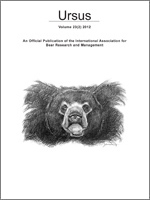The Louisiana black bear (Ursus americanus luteolus) is comprised of 3 subpopulations, each being small, geographically isolated, and vulnerable to extinction. Hurricanes Katrina and Rita struck the Louisiana and Mississippi coasts in 2005, potentially altering habitat occupied by this federally threatened subspecies. We used data collected on radio-telemetered bears from 1993 to 1995 and pre-hurricane landscape data to develop a habitat model based on the Mahalanobis distance (D2) statistic. We then applied that model to post-hurricane landscape data where the telemetry data were collected (i.e., occupied study area) and where bear range expansion might occur (i.e., unoccupied study area) to quantify habitat loss or gain. The D2 model indicated that quality bear habitat was associated with areas of high mast-producing forest density, low water body density, and moderate forest patchiness. Cross-validation and testing on an independent data set in central Louisiana indicated that prediction and transferability of the model were good. Suitable bear habitat decreased from 348 to 345 km2 (0.9%) within the occupied study area and decreased from 34,383 to 33,891 km2 (1.4%) in the unoccupied study area following the hurricanes. Our analysis indicated that bear habitat was not significantly degraded by the hurricanes, although changes that could have occurred on a microhabitat level would be more difficult to detect at the resolution we used. We suggest that managers continue to monitor the possible long-term effects of these hurricanes (e.g., vegetation changes from flooding, introduction of toxic chemicals, or water quality changes).
How to translate text using browser tools
1 November 2012
Effects of hurricanes Katrina and Rita on Louisiana black bear habitat
Jennifer L. Murrow,
Joseph D. Clark
ACCESS THE FULL ARTICLE

Ursus
Vol. 23 • No. 2
November 2012
Vol. 23 • No. 2
November 2012
forest
habitat modeling
Hurricane Katrina
Hurricane Rita
Louisiana black bear
Mahalanobis distance
Ursus americanus luteolus




